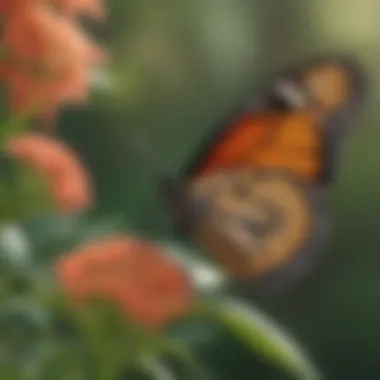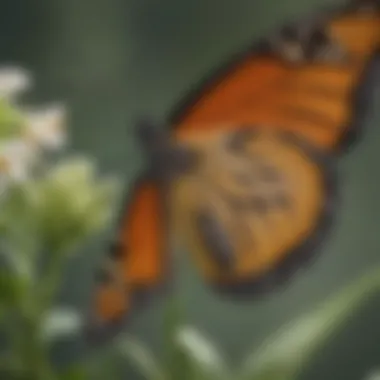Discovering the Intriguing Mystery of Monarchs' Milkweed Quest


Nature Topic Overview
Monarchs, in their quest to find milkweed, showcase a mesmerizing ballet of instinct and innate navigation prowess 🌿🦋 Exploring this captivating journey sheds light on the symphony of nature's design as these delicate creatures embark on their vital search.
Fun Facts and Trivia
Dive into the intriguing world of monarch butterflies with captivating trivia that will pique the curiosity of young minds 🌟 Did you know that monarchs can travel up to 3,000 miles during migration, relying on environmental cues to guide them along their epic journey?
Wildlife Explorations
Unveil the interconnected ecosystem of monarch butterflies and milkweed plants, highlighting the symbiotic relationship that exists in their habitat 🌎 Discover the importance of preserving these critical species through interactive features that engage and educate.
Environmental Awareness
Delve into the crucial role of conservation in safeguarding the delicate balance of nature, emphasizing the significance of protecting milkweed plants and monarch butterfly populations 🌿🦋 Empower children with actionable tips on how they can contribute to environmental sustainability.
DIY Nature Activities
Inspire young nature enthusiasts with hands-on activities and experiments to deepen their understanding of monarch butterfly biology and habitat 🍃 From creating butterfly-friendly gardens to conducting scientific observations, encourage outdoor explorations that foster a deeper connection to the natural world.
Prelude


In this section, we delve into the intriguing phenomenon of how monarch butterflies manage to locate vital milkweed plants to facilitate their critical life cycle stages. This exploration promises to unveil the intricacies hiding behind the majestic butterflies' behavior, shedding light on the remarkable strategies they employ to navigate their search for milkweed, fundamental for their very survival.
Understanding Monarch Butterflies
Monarch butterflies, with their distinctive orange and black patterned wings, are a marvel of nature. These creatures undergo a miraculous transformation from caterpillars to graceful butterflies during their life cycle. Understanding the biology, behavior, and habitats of these delicate insects is crucial in appreciating their role in the ecosystem and the significance of preserving their existence.
Significance of Milkweed to Monarchs
The humble milkweed plant plays a crucial role in the life of monarch butterflies. It serves as the exclusive host plant for their eggs and food source for their larvae. The relationship between monarchs and milkweed is a delicate balance that underscores the dependency of these butterflies on this specific plant for their survival and reproduction.
Importance of Navigation in Monarchs
Navigation is a critical skill for monarch butterflies, especially in their quest to find milkweed for mating and laying eggs. The capacity of these insects to navigate vast distances during migration is awe-inspiring. By delving into the mechanisms that enable monarchs to traverse great lengths with precision, we gain a deeper appreciation for their remarkable abilities in locating milkweed amidst varied landscapes.
Sensory Tools Utilized by Monarchs
Monarchs possess a sophisticated array of sensory tools vital for their survival. Understanding the sensory mechanisms they employ illuminates the intricacies of their behavior. By utilizing chemoreception, visual cues, and magnetic field orientation, monarch butterflies navigate their way to milkweed, crucial for their life cycle.
Chemoreception: Smelling Milkweed
The olfactory senses of monarch butterflies play a pivotal role in detecting the alluring aroma of milkweed. Through specialized receptors, they are capable of discerning minute scent particles, guiding them towards suitable milkweed plants for oviposition. The chemical composition of odors from milkweed triggers specific neural pathways in monarchs, fine-tuning their ability to locate this essential plant.
Visual Cues for Locating Milkweed


Monarchs also rely on visual cues to aid in the identification of milkweed amidst a sea of vegetation. Their keen eyesight allows them to detect color contrasts, shapes, and patterns unique to milkweed plants. By honing in on these visual markers, monarch butterflies efficiently zero in on their preferred host plants, ensuring the continuation of their life cycle.
Magnetic Field Orientation in Monarchs
Furthermore, monarch butterflies demonstrate a remarkable sensitivity to Earth's magnetic field. This innate ability enables them to orient themselves with precision during migration and milkweed location. By aligning themselves with the geomagnetic field, monarchs can maintain a consistent heading towards regions abundant in milkweed, showcasing the intricate relationship between their sensory capabilities and navigational prowess.
Migration Patterns and Milkweed Finding
Migration Patterns and Milkweed Finding play a crucial role in the life of monarch butterflies, serving as a cornerstone of their survival strategy. Understanding the seasonal movements and the intricate relationship between monarchs and milkweed is essential in grasping the complexities of this symbiotic interaction. The ability of monarch butterflies to locate milkweed during their migration is vital for sustaining their population and ensuring successful reproduction.
Seasonal Migration of Monarchs
Monarch butterflies embark on a remarkable journey during their seasonal migration, spanning thousands of miles across continents. As they navigate through varying landscapes and climates, monarchs rely on their innate instinct to guide them towards milkweed-rich habitats. This annual migration is a test of endurance and resilience for these delicate creatures, emphasizing the importance of conserving their critical habitats to support their journey.
Memory and Learning in Milkweed Location
The process of memory and learning plays a significant role in monarch butterflies' ability to locate milkweed. Through a combination of genetic encoding and environmental cues, monarchs develop a precise memory of milkweed locations. This memory is crucial for future generations as it ensures the passing down of vital information for successful migration and reproduction. The intricate process of learning and remembering milkweed sites highlights the intelligence and adaptability of these elegant insects.
Influential Factors in Finding Milkweed
Various influential factors contribute to monarch butterflies' successful location of milkweed. External elements such as weather patterns, plant diversity, and habitat stability play a vital role in determining the availability of milkweed along migration routes. Additionally, internal factors like biological rhythms and hormonal changes also impact monarchs' ability to find suitable milkweed sites. Understanding these complex interactions is key to supporting monarch populations and conserving their essential habitats.


Challenges in Locating Milkweed
The intricacies surrounding the challenges of locating milkweed are pivotal in understanding the survival dynamics of monarch butterflies. In a world where natural habitats are continually diminishing due to various external factors, monarch butterflies face heightened pressure in their quest for sustaining their life cycle. The significance of these challenges reverberates across ecosystems, placing emphasis on the critical balance needed for the survival of these majestic pollinators. Exploring the core elements that contribute to the hurdles in finding milkweed sheds light on the delicate interplay between monarchs and their environment. By delving into the symbiotic relationship between monarch butterflies and milkweed, we unravel the fundamental essence of ecological harmony and the irreplaceable role that milkweed plays in sustaining biodiversity. An in-depth examination of the challenges in locating milkweed unravels a tapestry of interconnectedness within nature's framework, highlighting the beautiful yet fragile coexistence of species.
Loss of Habitat and Impact on Monarchs
The loss of natural habitats poses a significant threat to the monarch population, leading to a cascading effect on their ability to locate essential milkweed plants. Human-driven activities such as deforestation, urbanization, and agricultural expansion have substantially reduced the availability of milkweed habitats crucial for monarch reproduction and sustenance. This loss reverberates through the monarch life cycle, disrupting their navigation patterns and diminishing their capacity to find suitable locations for egg-laying and feeding. The impact of habitat loss on monarchs manifests in decreased population numbers, altered migratory patterns, and heightened vulnerability to predation and environmental stressors. Understanding the direct correlation between habitat loss and the monarch's struggle to find milkweed underscores the urgent need for conservation efforts to mitigate these detrimental effects and safeguard the future of this iconic species.
Climate Change and Milkweed Distribution
The intricate dance of climate change exerts a profound influence on milkweed distribution, directly impacting the monarch butterfly's ability to locate essential host plants. Shifts in temperature, precipitation patterns, and seasonal variations disrupt the traditional range of milkweed habitats, leading to mismatches in growth cycles and availability. As climate change induces alterations in plant phenology and geographical distributions, monarch butterflies face the challenge of adapting to these dynamic environmental conditions, testing their navigational capabilities and resource-findng strategies. The subsequent consequences of climate change on milkweed distribution resonate through the monarch population, necessitating a reevaluation of conservation strategies and ecosystem management approaches to ensure the continued availability of vital resources for these resilient insects.
Human Intervention and its Effects
Human intervention in natural environments presents a complex set of challenges for monarch butterflies in their quest to locate milkweed. The expansion of urban areas, intensive agricultural practices, pesticide usage, and land development activities significantly contribute to the degradation and fragmentation of milkweed habitats, impeding the monarch's ability to fulfill their essential life cycle requirements. The unintended consequences of human actions on monarch populations extend beyond habitat loss to include factors such as pollution, habitat degradation, and resource scarcity, all of which intensify the struggle for monarchs to locate suitable milkweed sites. Acknowledging the multifaceted effects of human intervention on monarchs underscores the necessity for collaborative conservation efforts, community engagement, and sustainable land management practices to preserve milkweed habitats and ensure a thriving future for monarch populations.
Conservation Efforts and the Future
Conservation efforts and the future of monarch butterflies hold paramount importance in ensuring the survival of these exquisite creatures. With increasing threats to their natural habitats and food sources, it becomes imperative to implement strategic measures for their preservation. In this section, we will delve into the significant aspects related to the conservation of monarch butterflies and shed light on the strategies that can shape a positive future for these majestic insects.
First and foremost, understanding the key factors driving the decline in monarch populations is crucial. Loss of habitat due to urbanization, agriculture, and deforestation has severely impacted the availability of milkweed plants, essential for monarch survival. Climate change further exacerbates this situation, altering the distribution of milkweed and disrupting monarch migration patterns. By grasping these challenges, conservation efforts can be tailored to address the root causes of diminishing monarch populations.
Moreover, the role of conservation programs in safeguarding monarch habitats cannot be understated. Initiatives focusing on creating and preserving milkweed-rich environments help provide the necessary resources for monarchs to thrive. By collaborating with local communities, governments, and conservation organizations, these programs play a vital role in ensuring the longevity of monarch populations. Through habitat restoration, captive breeding, and public awareness campaigns, monarch conservation programs actively work towards securing a brighter future for these iconic butterflies.
Looking ahead, technological advancements offer promising tools for monitoring monarch populations and tracking their movements. By utilizing satellite imagery, geographic information systems (GIS), and citizen science initiatives, researchers can gather valuable data on monarch behavior and habitat usage. These technological innovations enhance our understanding of monarch ecology, aiding conservation efforts through informed decision-making and targeted interventions.
In parallel, educational initiatives play a pivotal role in raising awareness about the importance of milkweed for monarch butterflies. By engaging schools, nature centers, and the broader community, educational programs foster a culture of conservation and environmental stewardship. Through hands-on activities, interactive workshops, and outreach events, these initiatives empower individuals to take action in protecting monarch habitats and promoting biodiversity.
In essence, the convergence of conservation efforts, technological innovation, and educational outreach forms a multifaceted approach to secure the future of monarch butterflies. By fostering a collective commitment to monarch conservation, we can ensure that these enchanting insects continue to grace our landscapes for generations to come.







